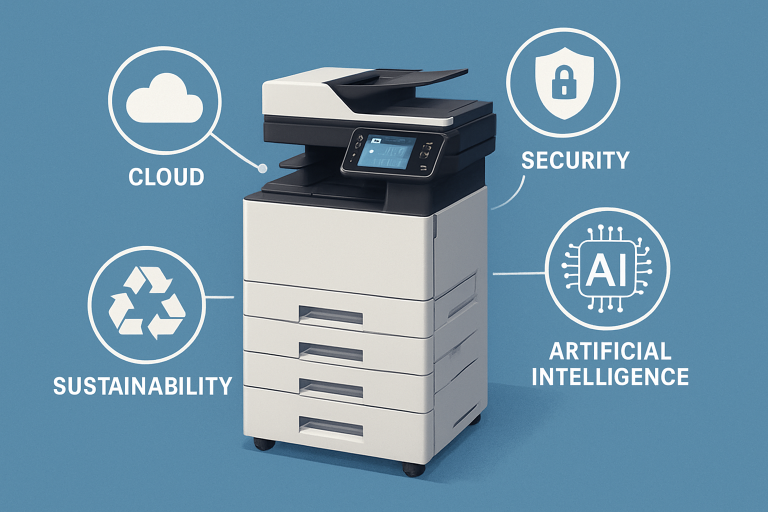How Smart Printing Technology Is Changing Today’s Workplaces
Modern offices demand more than speed—they require adaptability, intelligence, and seamless integration with digital workflows. As innovative printing technology advances, it’s revolutionizing how organizations manage their documents, protect sensitive data, and support evolving work styles. Businesses are quickly discovering that these innovations drive efficiency and offer tangible operational advantages, making them indispensable. For an in-depth look into the benefits of commercial printers, it’s evident how prime these technologies are for any business environment.
The need to automate tasks and maintain robust security grows as the workplace becomes increasingly digital and distributed. Innovative printers with the latest AI and cloud-based features directly address these challenges while supporting sustainability and quality control initiatives. These improvements empower employees to be more productive, agile, and environmentally conscious in their day-to-day work.
Digital transformation permeates every office process—including printing—allowing organizations to safeguard information better, streamline operations, and lower operational costs. These print solutions reduce manual intervention and free up valuable employee time for high-value activities, making scalable efficiency achievable for companies of all sizes.
Whether in a bustling corporate headquarters or a remote home office, innovative printers enable companies to embrace hybrid work arrangements, optimize device usage, and lower their carbon footprint. This next generation of technology is fundamentally redefining productivity in the digital age.
Streamlining Workflows with AI
Artificial Intelligence (AI) has become a cornerstone of efficient document workflows. With innovative printers, AI is now integrated into automating job scheduling, prioritizing urgent tasks, and making real-time print settings adjustments. This level of automation minimizes human error and ensures optimal use of resources such as paper and toner. Employees, in turn, gain time to tackle mission-critical duties, significantly increasing their overall productivity and job satisfaction.
Automated workflow solutions can be particularly vital in sectors where document management is central—like healthcare, law, and finance. For instance, intelligent print queues and digital routing capabilities can streamline patient records, legal filings, or sensitive financial documents while adhering to compliance standards. According to industry research, larger organizations report measurable cost reductions and workflow improvements after adopting these AI-powered tools.

Enhancing Security Measures
Rising cyber threats have made document security an essential feature of any workplace print solution. Innovative printers are designed with robust security standards, incorporating encrypted hard drives to defend against data breaches and providing secure authentication—such as PIN codes or badge release—before releasing sensitive documents. These measures significantly mitigate risks related to data theft and unauthorized access.
Beyond hardware-level security, some systems offer full audit trails and detailed reporting, so businesses can instantly monitor print activity for compliance and detect suspicious behavior. Integration with company-wide IT security policies ensures that every printed document is safeguarded from end to end, making innovative printers a must-have for organizations working with confidential or proprietary data.
Supporting Hybrid Work Environments
As remote and hybrid work arrangements become more common, the ability to print securely from anywhere has become critical. Innovative printing technology rises to this challenge by supporting cloud-based printing platforms. Employees can send print jobs from home, on-site, or while traveling and retrieve documents at any connected office printer. This flexibility is vital for distributed teams that require uninterrupted access to business documents.
Cloud solutions streamline document access and enforce company print policies regardless of employees’ location. Mobile printing features further enhance this flexibility, offering secure printing with smartphones or tablets—a necessity in today’s fast-evolving work environments. According to Forbes, such agility is crucial for organizations seeking resilience amid changing work patterns.
Promoting Sustainability
Environmental responsibility is now a competitive differentiator for businesses. Innovative printers help enterprises reduce their carbon footprint by optimizing print layouts, enforcing two-sided printing, and automating toner usage. These energy-efficient devices are built to minimize waste and maximize the use of recycled materials, aligning with corporate and regulatory sustainability mandates.
Some advanced models come with built-in analytics tools, enabling monitoring usage trends and the generation of reports on paper and power savings. These digital features allow organizations to set quantifiable sustainability targets and track progress in real time. By deploying smarter, greener printers, companies take measurable steps toward resource conservation and environmental stewardship.
Improving Print Quality and Control
The integration of AI has dramatically elevated print quality within office environments. Real-time monitoring systems detect and correct errors—such as misalignments, poor image resolution, or color inconsistencies—before a job is completed. This exacting level of control ensures that every print project achieves uniform, professional quality while reducing material waste from unusable copies.
Furthermore, centralized print management dashboards give IT teams unprecedented oversight. They can allocate budgets, set print permissions, and generate department usage reports. This enables better cost control and sharpens accountability, which is essential for modern businesses navigating tightening margins and heightened compliance requirements.
Future Trends in Smart Printing
The future of workplace printing lies in the intersection of AI, cloud computing, and the Internet of Things (IoT). Predictive maintenance is one expected breakthrough—printers will soon be able to diagnose issues, request remote troubleshooting, or order replacement parts and supplies automatically, drastically reducing device downtime.
Another trend is deeper integration with business software suites, offering even more seamless workflows and document management solutions. In the near term, machine learning will continue to refine print usage predictions and drive proactive improvements in cost reduction, security, and environmental impact. These forward-thinking advancements ensure that smart printing will remain at the core of the connected, resilient workplace.
As organizations embrace these innovations, they’re not just improving their print processes—they’re setting a new standard for workplace productivity and adaptability, preparing themselves for tomorrow’s challenges today.
Visit the rest of the site for more interesting and useful articles.

